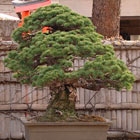Don visited the Bonsai Village, Omiya, Saitama Prefecture, where many of the top Japanese bonsai artists live. He felt very privileged to meet Mr Saburo Kato, the most famous bonsai artist in the village, and speak to him about his extraordinary creations.
The Village
The Bonsai Village was established in Omiya in 1925, two years after the Great Kanto earthquake. Bonsai growers from the Hongo area in Tokyo learned a valuable lesson from the quake. They decided to move to Omiya where there was good soil for nurturing bonsai with clean water and fresh air. Nowadays the Bonsai Village regularly hosts young trainees from Europe and the United States, as well as entertaining 10,000 visitors from abroad every year.
Saburo Kato
Born in 1915, Saburo Kato carried on in the footsteps of his father, bonsai master Tomekichi Kato. Saburo was involved in the establishment of the Omiya Bonsai Village, then when his father died in 1946 he became the third generation owner of Mansei-en bonsai garden. Bonsai nurserymen suffered extreme hardships during the war, when very few patrons could afford to buy bonsai. Ironically, it was the American GI’s of the Occupation Forces who became interested in bonsai and encouraged the nurserymen to continue and preserve their trade.
Saburo speaks of the ‘spirit and philosophy of bonsai’ and how bonsai must be a vehicle for world peace. He has always tried to build on the fact that everyone admires and enjoys bonsai, and this can lead to friendships between individuals, organisations and countries.
Saburo’s two sons now share the responsibility of running the family nursery. Hatsugi, who has worked with his father since finishing school, is dedicated to furthering the understanding and practice of bonsai. On the day we visited, he demonstrated how a bonsai plant is root pruned. This is done in very late winter or early spring. Every few years a proportion of the root system is taken off – how much depends on the size of the plant, but it is rarely more than about a third. The plant is then put back into the same pot with fresh potting mix.
Bonsai at Mansei-en
Saburo is well known for his precise, accurate shaping techniques and his talent of discovering and enhancing the natural beauty of a plant. He is also very popular for his humorous lectures. He showed Don two of his best bonsai. One is a very rare Japanese zelkova (Zelkova serrata), which he values for many reasons but especially because there are many equally balanced branches. The other is a sargent’s juniper (Juniperus sargentii) which is said to be 1000 years old, although Mr Kato thinks it is more than 1200 years old.
Further information
Our story was filmed with:
Mr Saburo Kato
Mansei-en
285 Bonsai-cho
Saitama City, Saitama Prefecture
Phone: 048 663 2636
JALPAK
Japan Specialists Information
SYDNEY: (02) 9285 6603/6611
MELBOURNE: (03) 8662 8350
ADELAIDE: (08) 8231 5399
BRISBANE: (07) 3221 2200
GOLD COAST: (07) 5582 6855
CAIRNS: (07) 4031 2700
or
for Travel Agents: 1800 221 760
For information on the techniques of bonsai join a club in your area. Lists of Australian bonsai clubs are on the internet at www.zeta.org.au/~djterry/bonclubs.htm and www.bonsaisite.org/clubs



